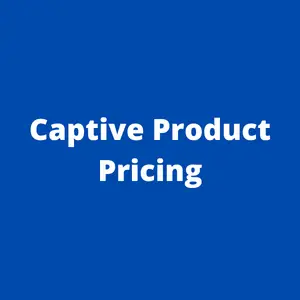Let’s suppose you bought a new printer. But there is no point in owning a printer without buying any cartridges. So, you go ahead and buy a pair of cartridges to make use of the printer.
A few months later, you run out of cartridges and are, in a way, forced to buy them again. During the lifetime of using this printer, it is likely that you could end up spending more money on cartridges cumulatively than you spent on buying the printer.
If this happens to the case, the company you have bought the printer from would also end up making more money from the sales of cartridges in the long term than the sale of the printer. Because more often than not, printers are designed to work with cartridges of only the company that sells the printer. You may or may not have realized this before, but this is an embodiment of the captive product pricing strategy.
Under the Captive Product Pricing Strategy, a company sells products based on one core product, which also needs multiple accessory or captive products to function. In many cases, core products are priced reasonably, and companies make little profit from them, and captive products are priced highly, and companies make most of the profit from the sale of these products.
The Captive Product Pricing strategy attracts consumers with a reasonably priced core product, creates a lock-in, and makes them buy captive products multiple times over the lifetime of the core product because essentially, the core product wouldn’t work without the captive product.
3 Real-Life Examples of Captive Product Pricing
Video Game Consoles
Game Consoles are the archetype of Captive Product Pricing. The core product, the gaming console like an Xbox, would be useless without accessory products like the controllers & games.
Game console creators create a lock-in by ensuring that only they can produce the captive products needed for the core product. To give an example, Xbox games only work with Microsoft gaming products; not with Nintendo or Sony games. This way, companies benefit themselves even though consumers are forced to buy multiple consoles to play different games.
Razors & Razor Blades
Gillete is a classic example of captive product pricing. The company sells razors at a dirt cheap price and sells disposable razors to customers multiple times during the lifetime of the razor. An important thing to note is that these blades are only compatible with the Gillette razor, creating an artificial lock-in for the customer.
Coffee Maker & Coffee Pods
Keurig, a well-known coffee brand, prices its Coffee maker, the core product, at around $100. However, coffee pods, the captive product, in this case, is priced at about $15-$25 for a pack of 24.
Now let’s suppose you need 50 pods to get through a month. If you were to consider an average price of $20 and buy two boxes a month, that would translate to a monthly expense of $40. By the end of the year, you would have spent $480 on coffee pods, $380 more than the $100 you paid to buy the Keurig coffee maker in the first place.
Captive Product Pricing Advantages
Increased Lifetime Revenue
The synergistic working of core and captive products ensures that once customers buy the core product once, they have to keep buying the captive product from the same company, in most cases. This strategic product development increases lifetime revenue generated from one customer and thereby increases profit.
Cross-Selling Opportunities
Suppose customers begin to prefer the products sold using the captive product pricing strategy. In that case, they are also more likely to check out other products by the same brand, allowing brands to make cross-sales and turn customers into brand loyalists.
Captive Product Pricing Disadvantages
Customer Dissatisfaction
In some cases, conscious customers could feel dissatisfied due to having to spend money on captive products to use the core products, especially in cases where the captive are unreasonably priced high. This dissatisfaction can also have a negative impact on the brand image and make customers look in the direction of competitive brands.
In conclusion, the captive pricing strategy, if used well, can lead to an increase in revenue by creating a mechanism for customers to buy repeatedly from the same brand. However, the captive model weakness can also be exploited by an upstart to take on established players by creating a product that doesn’t adhere to the captive model of the existing market.
![Captive Pricing [Definition, Examples, Advantages & Disadvantages]](https://whatisthebusinessmodelof.com/wp-content/uploads/2021/11/CaptiveProductPricingSrategy.png)
